Related Research Articles
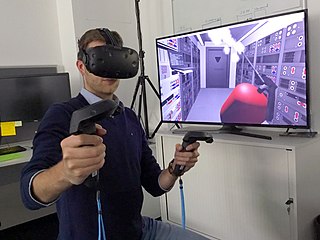
Virtual reality (VR) is a simulated experience that can be similar to or completely different from the real world. Applications of virtual reality can include entertainment and educational purposes. Other, distinct types of VR style technology include augmented reality and mixed reality.

Augmented reality (AR) is an interactive experience of a real-world environment where the objects that reside in the real world are enhanced by computer-generated perceptual information, sometimes across multiple sensory modalities, including visual, auditory, haptic, somatosensory and olfactory. AR can be defined as a system that fulfills three basic features: a combination of real and virtual worlds, real-time interaction, and accurate 3D registration of virtual and real objects. The overlaid sensory information can be constructive, or destructive. This experience is seamlessly interwoven with the physical world such that it is perceived as an immersive aspect of the real environment. In this way, augmented reality alters one's ongoing perception of a real-world environment, whereas virtual reality completely replaces the user's real-world environment with a simulated one. Augmented reality is related to two largely synonymous terms: mixed reality and computer-mediated reality.
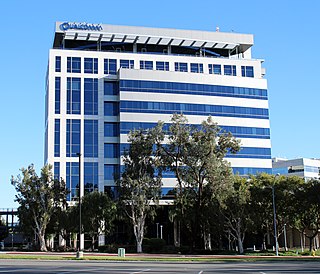
Qualcomm Incorporated is an American multinational semiconductor and telecommunications equipment company that designs and markets wireless telecommunications products and services. It derives most of its revenue from chipmaking and the bulk of its profit from patent licensing businesses. The company is headquartered in San Diego, California, United States, and has 224 locations worldwide. The parent company is Qualcomm Incorporated (Qualcomm), which has a number of wholly owned subsidiaries: Qualcomm CDMA Technologies (QCT) sells all of Qualcomm's products and services ; Qualcomm Technology Licensing (QTL) is responsible for the patent licensing business; and Qualcomm Technologies, Inc. (QTI) operates nearly all of Qualcomm's R&D activities.
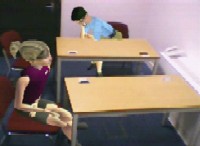
Mixed reality (MR) is the merging of real and virtual worlds to produce new environments and visualizations, where physical and digital objects co-exist and interact in real time. Mixed reality does not exclusively take place in either the physical or virtual world, but is a hybrid of reality and virtual reality, encompassing both augmented reality and augmented virtuality via immersive technology.
Jay David Bolter is the Wesley Chair of New Media and a professor in the School of Literature, Media, and Communication at the Georgia Institute of Technology. His areas of study include the evolution of media, the use of technology in education, and the role of computers in the writing process. More recently, he has conducted research in the area of augmented reality and mixed media. Bolter collaborates with researchers in the Augmented Environments Lab, co-directed with Blair MacIntyre, to create apps for entertainment, cultural heritage and education for smart phones and tablets. This supports his theory regarding remediation where he discusses "all media functions as remediators and that remediation offers us a means of interpreting the work of earlier media as well".

Unity is a cross-platform game engine developed by Unity Technologies, first announced and released in June 2005 at Apple Inc.'s Worldwide Developers Conference as a Mac OS X-exclusive game engine. As of 2018, the engine had been extended to support more than 25 platforms. The engine can be used to create three-dimensional, two-dimensional, virtual reality, and augmented reality games, as well as simulations and other experiences. The engine has been adopted by industries outside video gaming, such as film, automotive, architecture, engineering and construction.

Eric Paulos is an American computer scientist, artist, and inventor, best known for his early work on internet robotic teleoperation and is considered a founder of the field of Urban Computing, coining the term "urban computing" in 2004. His current work is in the areas of emancipation fabrication, cosmetic computing, citizen science, New Making Renaissance, Critical Making, Robotics, DIY Biology, DIY culture, Micro-volunteering, and the cultural critique of such technologies through New Media strategies.
A pervasive game is a Video, Role Playing (RPG), or Live Action Role Playing (LARP) game where the gaming experience is extended out in the real world, or where the fictive world in which the game takes place blends with the physical world. The "It's Alive" mobile games company described pervasive games as "games that surround you", while Montola, Stenros and Waern's book, Pervasive Games defines them as having "one or more salient features that expand the contractual magic circle of play spatially, temporally, or socially." The concept of a "magic circle" draws from the work of Johan Huizinga, who describes the boundaries of play.

ARToolKit is an open-source computer tracking library for creation of strong augmented reality applications that overlay virtual imagery on the real world. Currently, it is maintained as an open-source project hosted on GitHub. ARToolKit is a very widely used AR tracking library with over 160,000 downloads on its last public release in 2004.

UC Browser is a web browser developed by the Singapore/China-based mobile Internet company UCWeb, which is in turn owned by the Alibaba Group. I It is more popular than Google's Chrome in some of Asia's fastest-growing markets like India and Indonesia.

The California Institute for Telecommunications and Information Technology (Calit2, previously Cal(IT)2), also referred to as the Qualcomm Institute at its San Diego branch, is a $400 million academic research institution jointly run by the University of California San Diego (UCSD) and the University of California, Irvine (UCI). Calit2 was established in 2000 as one of the four UC Gray Davis Institutes for Science and Innovation. As a multidisciplinary research institution, it is conducting research discovering new ways in which emerging technologies can improve the state's economy and citizens' quality of life. Keeping in mind its goal of addressing large-scale societal issues, Calit2 extends beyond education and research by also focusing on the development and deployment of prototype infrastructure for testing new solutions in real world environments. Calit2 also provides an academic research environment in which students can work alongside industry professionals to take part in conducting research and prototyping and testing new technologies.
Elizabeth D. "Beth" Mynatt is the executive director of the Institute for People and Technology, the former director of the GVU Center at Georgia Tech; and professor in the School of Interactive Computing, all at the Georgia Institute of Technology.

WebGL is a JavaScript API for rendering interactive 2D and 3D graphics within any compatible web browser without the use of plug-ins. WebGL is fully integrated with other web standards, allowing GPU-accelerated usage of physics and image processing and effects as part of the web page canvas. WebGL elements can be mixed with other HTML elements and composited with other parts of the page or page background. WebGL programs consist of control code written in JavaScript and shader code that is written in OpenGL ES Shading Language (ESSL), a language similar to C or C++, and is executed on a computer's graphics processing unit (GPU). WebGL is designed and maintained by the non-profit Khronos Group.
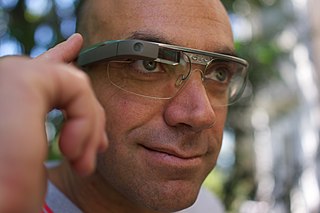
An optical head-mounted display (OHMD) is a wearable device that has the capability of reflecting projected images as well as allowing the user to see through it, similar to augmented reality technology. OHMD technology has existed since 1997 in various forms, but despite a number of attempts from industry, has yet to be commercialised.
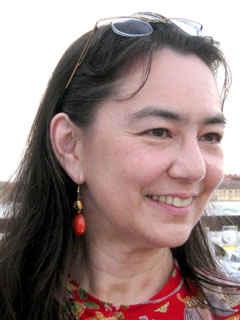
Tamiko Thiel is an American artist, known for her digital art. Her work is often "exploring the interplay of place, space, the body and cultural identity," and utilizing augmented reality (AR) as her platform. Thiel is based in Munich, Germany.
Tango was an augmented reality computing platform, developed and authored by the Advanced Technology and Projects (ATAP), a skunkworks division of Google. It used computer vision to enable mobile devices, such as smartphones and tablets, to detect their position relative to the world around them without using GPS or other external signals. This allowed application developers to create user experiences that include indoor navigation, 3D mapping, physical space measurement, environmental recognition, augmented reality, and windows into a virtual world.

Kubity is a cloud-based 3D communication tool that works on desktop computers, the web, smartphones, tablets, augmented reality gear, and virtual reality glasses. Kubity is powered by a proprietary 3D crystallization engine called "Paragone" that prepares the 3D file for transfer over mobile devices.
Steven K. Feiner is an American computer scientist, serving as Professor for computer science at Columbia University in the field of computer graphics. He is well-known for his research in augmented reality (AR), and co-author of Computer Graphics: Principles and Practice. He directs the Columbia University Computer Graphics and User Interface Lab.

Industrial augmented reality (IAR) is related to the application of augmented reality (AR) to support an industrial process. The use of IAR dates back to the 1990s with the work of Thomas Caudell and David Mizell about the application of AR at Boeing. Since then several applications of this technique over the years have been proposed showing its potential in supporting some industrial processes. Although there have been several advances in technology, IAR is still considered to be at an infant developmental stage.
References
- 1 2 "Blair MacIntyre". World Economic Forum. Retrieved June 3, 2012.
- ↑ "Qualcomm Establishes Augmented Reality Game Studio at Georgia Tech (Press Release)". SYS-CON Media. June 30, 2010. Retrieved June 3, 2012.
- ↑ "People of ACM - Blair MacIntyre", (March 21, 2017) Association for Computing Machinery . Retrieved February 28, 2018.
- ↑ Bozorgzadeh, Amir (February 1, 2018). "WebVR is becoming WebXR to make a simple, unified framework for all devices", VentureBeat . Retrieved February 28, 2018.
- ↑ Terraso, David (February 23, 2011). "Argon, the augmented reality web browser, available now on iPhone". PHYS.ORG. Retrieved June 3, 2012.